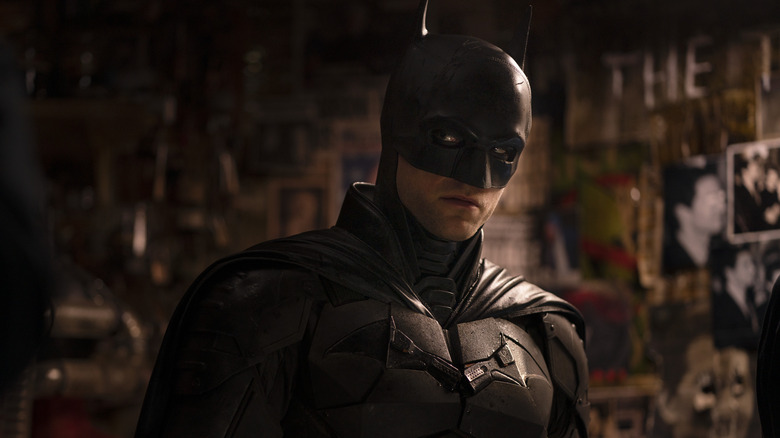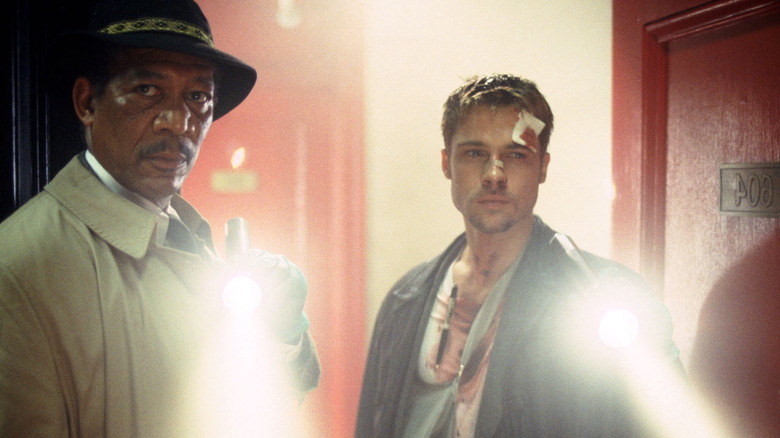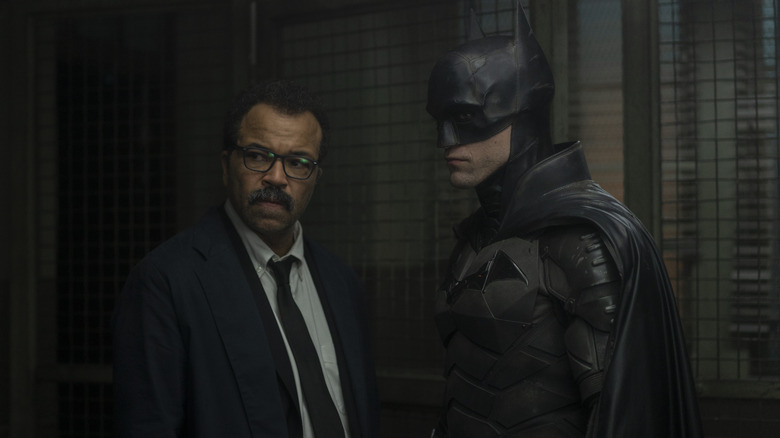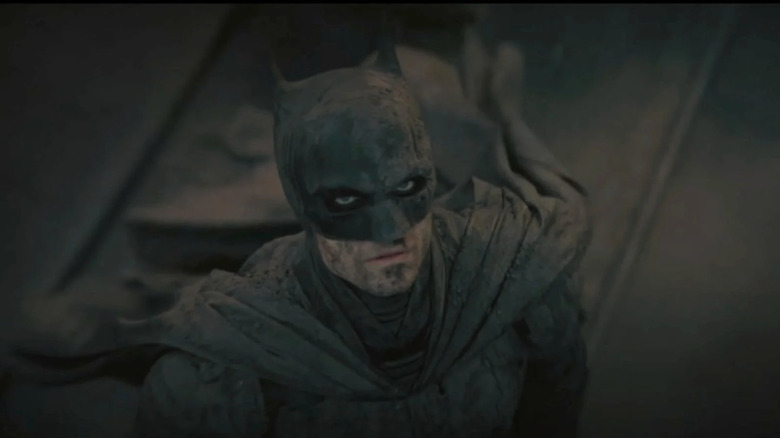The Batman Is Basically If Batman Was In Se7en, But That's Why It Rules, Actually
Matt Reeves's "The Batman" does many things really well. It gives us a Caped Crusader worthy of being called "World's Greatest Detective," a Gordon/Batman relationship so wholesome and good it feels like a "Teen Titans Go!" sketch, and a truly relatable and miserable sad boy Batman. But for me, the film's biggest achievement was making Gotham hell on Earth, a place so gross and violent it makes perfect sense that it'd birth a vigilante that hides in the shadows while dressed as a bat. And all of this owes a heavy debt to David Fincher's "Se7en."
David Fincher's seminal neo-noir crime thriller follows two detectives on the trail of a serial killer that targets his victims with elaborate crime scenes that recall the seven deadly sins. Not only is it a near-perfect film, but it already works quite well as a Batman movie. From the very start, "Se7en" makes it a point to never tell us what city the story takes place in, and Fincher very meticulously and purposely hides any mention of the city's name from both street signs and even police badges. Sirens and screaming are neverending background noise, people get stabbed in the eye for no reason, it rains all the time, and city officials are rotten to the core. The city has a lived-in feel to it, rich in detail and texture so it feels recognizable, but vague and formless so it feels like it belongs in another, darker world. It is a place devoid of hope and justice. It is Gotham City in everything but name.
'Hell burst through the pavement and grew'
The opening scene of "The Batman," arguably its best, feels like the entirety of "Se7en" condensed into a couple of minutes. We follow Robert Pattinson's weirdo Batman as he goes on patrol on a dark and stormy Halloween night as he narrates his thoughts into a journal. Where most of the recent "Batman" movies give us a rather superficial portrayal of Gotham, focusing on the big villains and key city figures like the mayor and his office, the police precinct, and the various Wayne Enterprises boardrooms, Matt Reeves gives us instead an eye-level view of the horror regular Gothamites face every day. From a bodega robbery, to a senseless attack at a train station, to a bridge underpass where the homeless try to find refuge in-between mob and police encounters. This is a Gotham so shaped by crime and sin, even the Halloween masks are grotesque and over the top (a prelude of the over-the-top villains that will soon terrorize the city). This is the darkest, most comics-accurate Gotham has been since Tim Burton's "Batman" built a city the director described as if "hell burst through the pavement and grew."
This brings to mind "Se7en" and the way Fincher makes the home of weary, cynical Detective Somerset a cesspool of scum and villainy. Like "The Batman," Fincher's neo-noir thriller establishes the hopelessness of the city where the action takes place in order to make you believe the kind of depraved villains that would call it home. And in the case of "The Batman," the streets of Gotham make you believe the only cure would be a guy dressing up as a bat. In Fincher's city of sin, even the main institutions are corrupted. When we first meet Morgan Freeman's Detective Somerset, he is asking a surprised cop if a dead kid at a crime scene saw his mother brutally kill his father before she killed him, and the cop just shrugs it off and asks why that matters.
This is a film where the press pays no attention to a series of grisly murders until it is someone of authority that dies, where the cops don't even bother checking if a victim is still alive before calling the homicide detective so they have to deal with it, where a serial killer literally walks into the precinct in broad daylight without anyone noticing.
'You have to hit them with a sledgehammer'
Speaking of serial killers, this is also where "The Batman" takes inspiration from "Se7en," whose John Doe is practically a Batman villain in all but name. With the brutality of someone like Victor Zsasz, and the over-the-top theatricals of someone like Calendar Man or even Riddler himself, John Doe is not just interested in killing, but sending a message. Both Riddler and John Doe leave elaborate crime scenes with deathtraps like Jigsaw from "Saw," with clues for the cops to find and riddles to solve. "Se7en" even ends on what is basically a riff on "The Killing Joke," with John Doe pushing the hero to madness and proving anyone can be like him. Both villains are also all about exposing the corruption of the city and seemingly punishing those who do wrong. For John Doe, it was about shocking the world out of its state of apathy, to "hit them with a sledgehammer" so they'd wake up.
The similarities to "Se7en" are not just superficial but instead are used as building blocks to make a different kind of Batman movie than we're used to. Matt Reeves uses the basis of Fincher's worldbuilding and seedy production design to create a noir-inspired thriller with a terrifying villain, a great mystery, and a fantastic setting. By building a comics-accurate Gotham, "The Batman" tells us everything we need to know about its take on Bruce Wayne and Batman without explaining too much. Just as Joker has always evolved with the portrayal of Gotham throughout the years, so does Batman reflect his city. This is not a Bruce Wayne who doubles as a playboy, or who has time to play hero — he is the personification of vengeance and fear.
"The Batman" also does something very different than "Se7en." While John Doe just wants to terrorize the city and kills a lot of random people in the process, Riddler is actually punishing those who genuinely broke Gotham. From the police department, the mayor, and the D.A., the Riddler's victims are guilty of crimes, and the people of Gotham even cheer along, applauding the Riddler's crusade of vengeance.
More than a symbol of fear
Back in 2019, a video essay theorized that "Se7en" could work if imagined as a prequel to Batman, because of the rather bleak way the film ended. "The Batman" makes that theory even more valid in the way Reeves rejects that bleak ending. This is the first Batman movie in quite a while to properly portray the Dark Knight as a symbol that strikes fear into the hearts of criminals, as we see them run away at the mere sight of the bat-signal. But this is also the first film to properly portray the turn from a vigilante that scares criminals away to a superhero that inspires hope.



